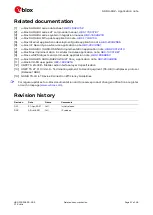
SARA-R42 - Application note
UBX-20050829 - R02
EFS backup & restore
Page 47 of 58
C1-Public
13
EFS backup & restore
Due to the nature of Flash memory, the Embedded File System (EFS) may incur memory corruption if
the safe & graceful shutdown procedure outlined in the SARA-R4 series system integration
manual
is not followed. It is possible that memory corruption may result in the device being
inoperable or impact specific device data information.
For a fatal memory corruption, the EFS backup & restore feature allows the module to autonomously
restore the EFS using the last EFS backup stored on the module itself.
Backup of device’s unique parameters (like for example RF calibration data, IMEI, etc
.) is performed at
the u-blox factory and is stored on the module as the first backup copy for the device. The host
application has the option to make subsequent backups to supersede the previous backup copy. If an
EFS corruption is detected, then the restore is triggered autonomously at the device boot-up process
to restore the device with the single backup copy stored on the device.
Backup & Restore is a unique feature that may extend the lifetime of the modules in the field.
☞
It is critical that the host application follows the proper safe & graceful shutdown procedure
outlined in the SARA-R4 series system integration manual
. Backup & Restore feature is
intended only as an additional backup mechanism if, on the potential rare occasion, the host
application shutdown is not conforming to the graceful power down guidelines.
13.1
Description
There are two parts to the EFS backup & restore feature for SARA-R4 series modules.
First, the Restore function allows the modules to automatically recover from a fatal file system
corruption if it should detect such a corruption from previous improper shutdown at the next module
boot-up. If the corruption is non-fatal, where the module can boot up, then the host can manually
trigger a restore.
These non-fatal corruption types are considered:
•
Lost of IMEI
•
MNO profiles lost or duplicated
•
Device goes into the non-signaling mode (for more details, see
+UTEST
AT command)
☞
A restore should be host triggered only in one of the above conditions.
The second part of this feature is optional for a device that comes with this feature from the factory,
where the host can perform a backup of the file system to supersede the previous or original backup
done during the module production. This will allow the latest user values in the file system to be
captured in the backup copy. The procedure could include security data, e.g. certificates.
☞
Only personalization data for security, calibrations and unique data will be restored. Instead, user
files, parameters and profiles will be set to default, i.e. they will not be considered by the backup
and restore process.












































